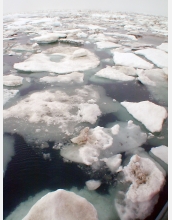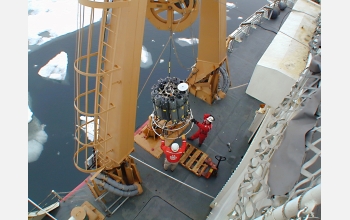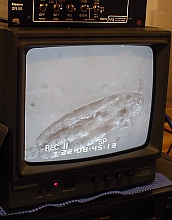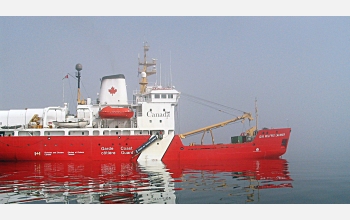All Images
News Release 06-042
Bering Sea Ecosystem Responding to Changes in Arctic Climate
Effects could extend from base of food chain to native hunters
This material is available primarily for archival purposes. Telephone numbers or other contact information may be out of date; please see current contact information at media contacts.

Arctic ice conditions have major impacts on both the creatures who live on the sea bottom and the predators who subsist on them.
Credit: Peter West, National Science Foundation
Download the high-resolution JPG version of the image. (2.1 MB)
Use your mouse to right-click (Mac users may need to Ctrl-click) the link above and choose the option that will save the file or target to your computer.

Jackie Grebmeier, an NSF-funded researcher at the University of Tennesee, prepares sediment samples taken from Arctic waters as part of the Western Shelf-Basin Interactions research project.
Credit: Peter West, National Science Foundation
Download the high-resolution JPG version of the image. (1.9 MB)
Use your mouse to right-click (Mac users may need to Ctrl-click) the link above and choose the option that will save the file or target to your computer.

CDTs, such as this one deployed by researchers on the U.S. Coast Guard icebreaker Healy sample such factors as salinity and temperature of Arctic waters.
Credit: Peter West, National Science Foundation
Download the high-resolution JPG version of the image. (2.2 MB)
Use your mouse to right-click (Mac users may need to Ctrl-click) the link above and choose the option that will save the file or target to your computer.

Small bottom-dwelling creatures such as these form the base of the Arctic food chain.
Credit: Peter West, National Science Foundation
Download the high-resolution JPG version of the image. (1.1 MB)
Use your mouse to right-click (Mac users may need to Ctrl-click) the link above and choose the option that will save the file or target to your computer.

Much of the research into changes in the Bering Sea was conducted cooperatively with Canadian scientists aboard the Canadian Coast Guard icebreaker Sir Wilfrid Laurier.
Credit: Jackie Grebmeier, University of Tennessee
Download the high-resolution JPG version of the image. (1.3 MB)
Use your mouse to right-click (Mac users may need to Ctrl-click) the link above and choose the option that will save the file or target to your computer.


